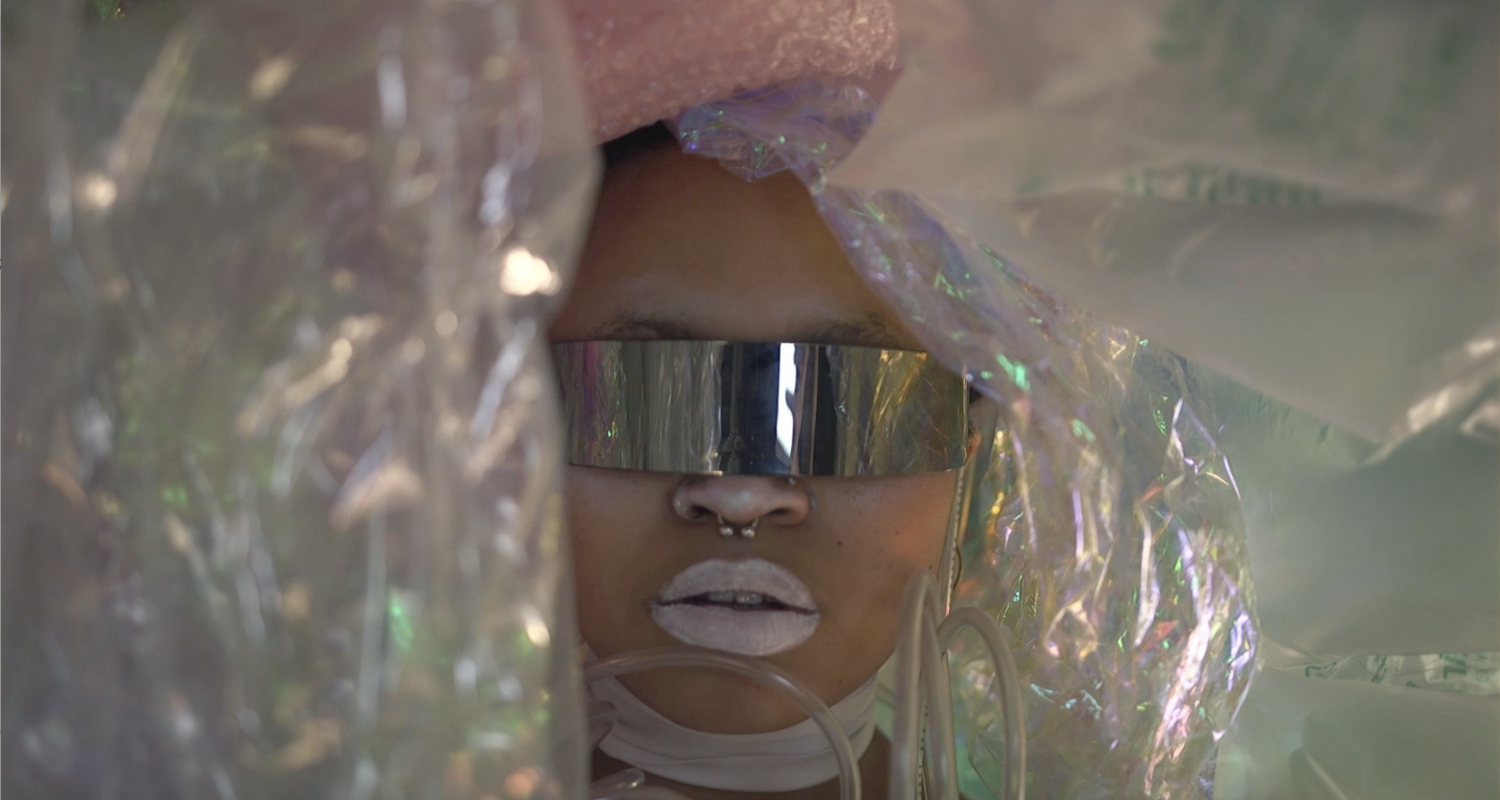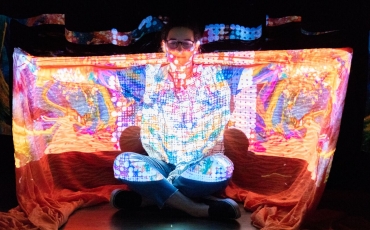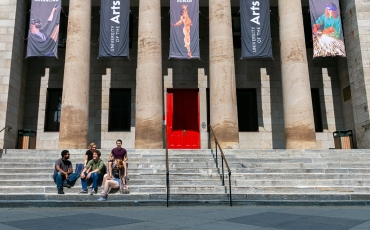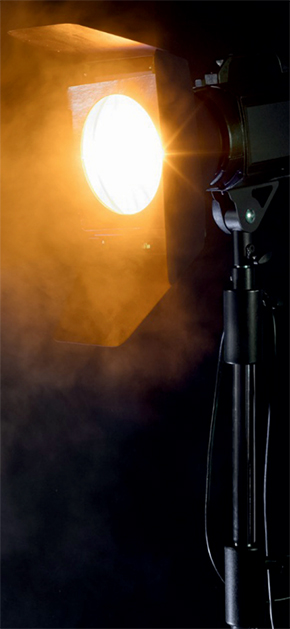
Film Design (BFA)
The Film Design program is not accepting applications for fall 2024.
The Bachelor of Fine Arts (BFA) in Film Design at University of the Arts in Philadelphia allows you to learn the creative and artistic areas of design involved in filmmaking.
You can become a production designer; an art director; or a designer of costumes, sets, lighting or sound. You’ll get a foundation in costumes, sets, lighting, sound and technical production, and then pick one or two chosen areas to concentrate on. Before you graduate, you’ll execute design work for a film project.
Header image still from Katarina Poljak's 2019 Senior Film.
Curriculum
Whether your medium is animation or digital video and film, the program is dedicated to helping you bring your ideas to life. You'll work closely with award-winning faculty and other creative students to develop your skills, understand the rich history of your medium, and express your personal vision as you immerse yourself in a challenging and rewarding career.
At UArts, students have three ways to study film:
Film (BFA)
Provides you with an environment where traditional ideas about moving images are challenged.
Film & Animation (BFA)
Allows you to explore the possibilities of both disciplines.
Film Design (BFA)
Allows you to concentrate on the creative and artistic areas of production design involved in filmmaking.
About the Film Design Curriculum
Sample Courses in the Film Design Major
The Film Design BFA program is an exploration of the creative and artistic areas of production design involved in filmmaking. The program is intended to develop film artists such as Production Designers, Art Directors, and designers of Costumes, Sets, Lighting, and Sound.
The program introduces students to each of these artistic focus areas in film – costumes, sets, lighting, sound, and technical production. After this foundation in film production design, the program builds student experience and skills in one or two chosen areas through a series of practicum courses – mentored guidance for a set of realized film projects. The program is capped with a thesis project in the final year that involves realized production design work on a film project and thorough documentation and formal presentation of the artistic process and methods involved.
Graduates of the Film Design program will:
- Understand the duties and functions of the various artists and technicians working in the film industry in production design roles (production designers, art directors, designers, film production staff members, etc.), and be able to perform professionally in one or more of these roles.
- Know and understand the history and development of film design and production and be able to identify, discuss, and apply the relevant styles, methods, and genres to new film projects.
- Be able to identify screenplay requirements and opportunities and to make creative, artistic, and strong production design choices to enhance work on a film project.
- Be proficient in finding, presenting, and applying visual and factual research in order to inform, describe, and develop creative ideas.
- Synthesize techniques and knowledge from multiple areas of production design to enhance a project (combining film design methods with those used in theater, for example).
- Be able to present, discuss, and negotiate between production design proposals to arrive at a collaborative and integrated project proposal, and to carry out the resulting project as effective members of the creative team.
Sample Curriculum
Duration: 4 years, full time
Credit Requirements: 120 credits
Major requirements: 62.5 credits
Discipline history: 9 credits
Critical Studies: 33 credits
Free electives: 15.5 credits
Fall Semester: 15 credits
The Art of Cinema (3c)
Image/Time (3c)
Intro to Film Design & Production (3c)
Writing I Placement (3c)
Free elective (your choice) (3c)
Spring Semester: 14 credits
Video Production (3c)
Theater Design & Technology course* (2c)
Set Design (3c)
Design Analysis in Screenwriting (3c)
Writing II Placement (3c)
Fall Semester: 16 credits
Production Design (3c)
The Art of Editing (3c)
Scenery & Prop Technology (1c)
Lighting Design (3c)
History of Narrative Cinema I (3c)
Thinking Through Science (3c)
Spring Semester: 16 credits
Cinematography (3c)
Sound Design (3c)
Film Forum: Selected Topics (3c)
Theater Design & Technology course* (2c)
Course in your area of focus** (1c)
Costume Technology (1c)
History of Narrative Cinema II (3c)
Fall Semester: 15 credits
Junior Production Workshop (3c)
Theater Design & Technology course* (2c)
Course in your area of focus** (1c)
Technical Direction (3c)
Critical Studies (your choice) (3c)
Critical Studies (your choice) (3c)
Spring Semester: 14 credits
Theater Design & Technology course* (2c)
Course in your area of focus** (1c)
Critical Studies (your choice) (3c)
Critical Studies (your choice) (3c)
Critical Studies (your choice) (3c)
Free elective (your choice) (2c)
Fall Semester: 15 credits
Senior Thesis I (3c)
Internship (1.5c)
History of Costume & Decor (3c)
Critical Studies (your choice) (3c)
Free elective (your choice) (3c)
Free elective (your choice) (1.5c)
Spring Semester: 15 credits
Senior Thesis II (3c)
Critical Studies (your choice) (3c)
Critical Studies (your choice) (3c)
Free elective (your choice) (3c)
Free elective (your choice) (3c)
Explore the Full Curriculum
Featured Faculty

Center for Immersive Media
UArts’ new Center for Immersive Media (CIM) is a 5,600-square-foot facility dedicated to exploring the fields of virtual and mixed reality, performance motion-capture, and human-computer interaction.
The space includes
- Optical motion capture system for full body performance capture and location-based VR applications;
- A four-channel audio system, multiple video projectors and lighting, as well as a control station;
- 16-station computing classroom with PCs optimized for real-time graphics rendering; and
- Two large project rooms with ceiling grids for development of installations and virtual environments.
How to Apply
UArts offers recommended priority deadlines; students who apply and submit all required materials by the priority deadline will receive first consideration for scholarship aid from UArts. Applications received after the priority deadline will be reviewed on a rolling, space-available basis.
International students requiring an F-1 visa for study in the U.S. might be subject to earlier deadlines to provide time for completion of the visa process. Contact Admissions for guidance if you are an international student who wishes to apply after the priority deadline.
Spring 2024 priority deadline: Oct. 15, 2023
Fall 2024 priority deadline: Feb. 15, 2024
We cannot accept spring 2024 applications after Jan. 8, 2024, and cannot accept fall 2024 applications after Aug. 16, 2024.
We encourage students to complete the FAFSA by March 15, if possible.
Many students and families have encountered technical challenges while trying to complete the FAFSA this year. If this is the case for you, continue to utilize the FAFSA support resources until your issue is resolved. UArts will ensure that all admitted students who file the FAFSA are eligible for the same institutional funding to support your costs.
The following materials are required for your application.
Start or resume your application.
-
The application includes two required short-answer questions: What excites you about UArts? What inspires you?
-
If you qualify for a fee waiver from NACAC, CollegeBoard, UArts or another source, indicate that on your application. If the cost of the application fee is a barrier, contact Admissions to request a fee waiver code.
-
Official transcripts must be sent directly from your school by mail, email or a secure electronic document-delivery service.
-
International transcript requirements
-
If you’ve attended high school outside the U.S., read the additional guidelines for international transcripts.
-
-
Transfer student transcript requirements
-
High school transcripts may be waived for transfer applicants who have completed a minimum of 24 credits of college-level coursework, including a minimum of 18 academic, non-studio credits.
-
Official college transcript(s)
-
Official transcripts must be sent directly from all the colleges you have attended by mail, email or a secure electronic document-delivery service.
-
If you’ve attended college outside the U.S., you are required to have an official course-by-course evaluation of your college coursework sent to UArts. Additional guidelines for international transcripts are available.
-
-
A portfolio is required for all Art, Design, Film and Writing programs. Your portfolio may be uploaded during the application process or via your applicant status portal after submission. You must confirm when your submission is complete via the linked electronic form before your portfolio can be reviewed for admission.
-
Letters of recommendation from teachers or mentors are optional and may be submitted by the recommender via email to undergradcredentials@uarts.edu or by your high school through a secure electronic document-delivery service.
About the School of Film
University of the Arts’ School of Film strongly believes in creative collaboration, self-expression and professional preparation through its programs in Animation, Film, Film and Animation, Film Design, Game Art, and Screenwriting.
It also offers minors in
- Animation,
- Film,
- Film and Media Studies,
- Game Art, and
- Screenwriting.
The School of Film prepares students for careers in the film and entertainment industries via internships, networking events and an on-campus series with professional alumni. Our graduates become directors, editors, animators, game artists, cinematographers, art directors and screenwriters, working in the region and around the world.
Get Started

Start your application
Begin your application today. Our admissions team will help you throughout the process.

See UArts for yourself
The best way to get to know UArts is by visiting our campus in person. Come see a show, visit a gallery, and get to know the neighborhood.

Not sure where to start?
We're glad you want to learn more. Our admissions team is happy to send additional information about our school.


